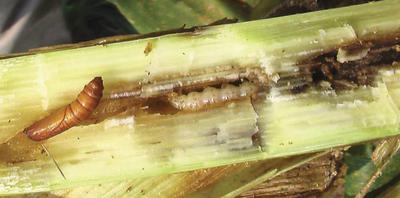Plassy Borer
Chilo tumidicostalis
Insect
5 mins to read
In a Nutshell
- Bore holes in top internodes.
- Hollow canes.
- Dry spindle and crown leaves.
- Whitish larvae with dark stripes or spots along the dorsal side and dark head.
Can also be found in
Symptoms
The incidence of the borer can be easily recognized by the presence of dried crown of infested sugarcane. Primary infestation is caused by newly hatched larvae aggregating in the top three to five internodes, ranging between 50 to 180 larvae in a single stalk. Several bore holes are apparent in the top internodes. The affected stalks are full with red colored frass. The cane is hollow and dries up the central spindle and crown leaves and breaks more easily. Nodes adjacent to the infested internode develop sett roots which completely envelop the stalk; sprouting of nodal buds also occurs. In the case of secondary infestation, grownup larvae disperse to either the lower healthy portion of the canes showing primary attack on the neighboring canes.
Recommendations

Organic Control
Cotesia flavipes and Trichogramma chilonis wasps are effective natural enemies of C. tumidicostalis. Use Tricho cards or vials to release in the field during mild climatic conditions.

Chemical Control
Always consider an integrated approach with preventive measures together with biological treatments if available. To this day we are not aware of any chemical control method available against this pest. Usually, chemical control measures are not effective. If you know of any successful method to reduce the incidence or the gravity of the symptoms, please contact us.
What caused it?
The damage is caused by the gregarious feeding activity of the larvae of Chilo tumidicostalis. Moths are cinnamon brown with terminal series of black spots broken externally by small silvery white points. Hind wings are whitish except for a few light brown scales in the front area of male moths. Thick hair can be seen in the anal parts of females. Females lay 500 to 800 eggs in batches in 4 to 5 rows on the leaf underside. The eggs are dirty white with a light greenish tinge but which turn red at the time of hatching. The larvae are gregarious, sluggish, white with black/orange head, which turns creamy at a later stage. The pupation takes place in the internodes. The pest population is favored by humid environments. Severe incidences are favored by heavy soils and water logged, or flooded fields.
Preventive Measures
- Monitor your field regularly for symptoms.
- Avoid water-logging.
- Install light traps to trap the adult moths.
- Collect and destroy egg masses and cane tops showing primary infestation.
- Remove dead hearts together with the borers and destroy both.
- Preserve natural enemies as they help control the pest population.



